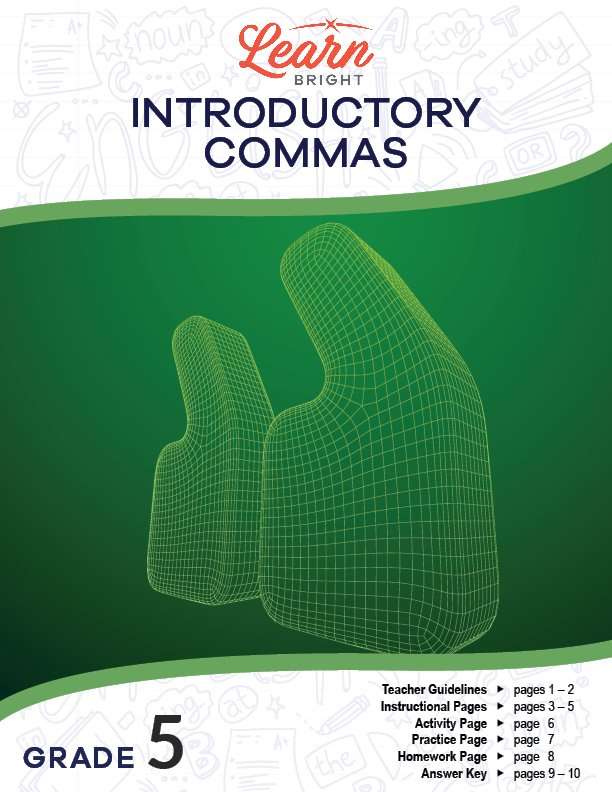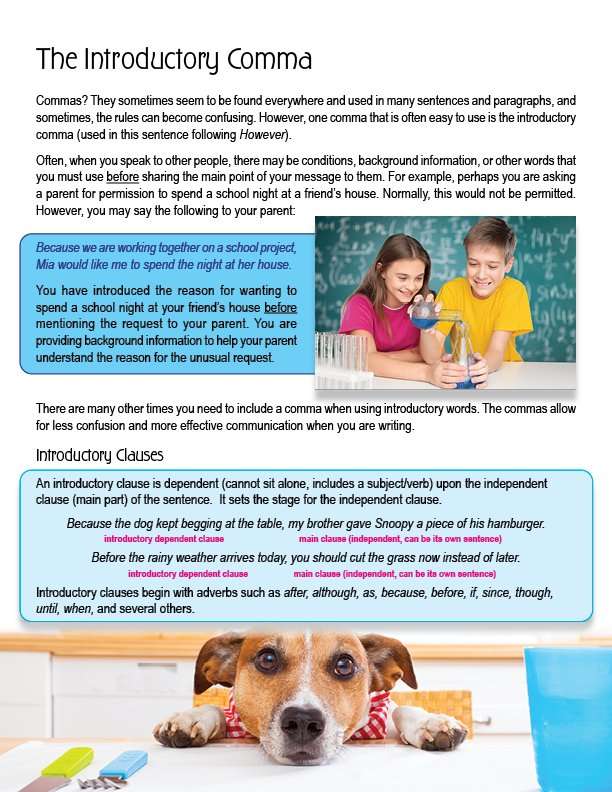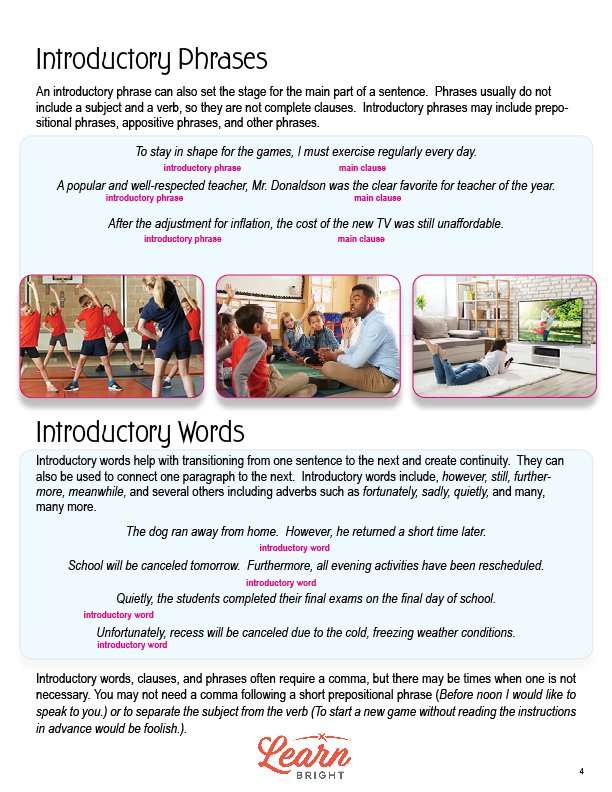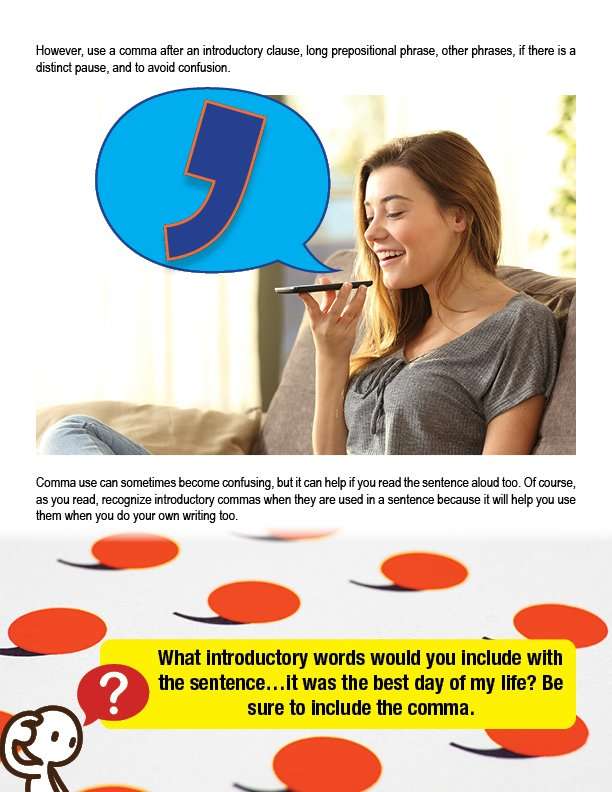Description
What our Introductory Commas lesson plan includes
Lesson Objectives and Overview: Introductory Commas lesson plan teaches students the basics of how to use commas properly in their writing. At the end of the lesson, students will be able to use a comma to separate an introductory element from the rest of the sentence. This lesson is for students in 5th grade.
Classroom Procedure
Every lesson plan provides you with a classroom procedure page that outlines a step-by-step guide to follow. You do not have to follow the guide exactly. The guide helps you organize the lesson and details when to hand out worksheets. It also lists information in the orange box that you might find useful. You will find the lesson objectives, state standards, and number of class sessions the lesson should take to complete in this area. In addition, it describes the supplies you will need as well as what and how you need to prepare beforehand. The only supplies you will need for this lesson are the handouts. To prepare for this lesson ahead of time, you can copy the handouts.
Options for Lesson
Included with this lesson is an “Options for Lesson” section that lists a number of suggestions for activities to add to the lesson or substitutions for the ones already in the lesson. An optional addition to the lesson activity is to have students create a poster using the sentences and add pictures. You can also add other words, phrases, and clauses to the activity. Another optional addition to the lesson is to have students use current reading material for practice identifying introductory words, phrases, and clauses. Your students can also create a quiz for the other students to complete. For an additional activity, you can have students complete in an Introductory Comma Bee where they read sentences aloud in teams and guess the placement of the comma. Finally, you can have students hold a conversation and say the word “comma” after the introductory words, phrases, or clauses.
Teacher Notes
The teacher notes page includes a paragraph with additional guidelines and things to think about as you begin to plan your lesson. It notes that students often forget to include commas after introductory words and phrases. This page also includes lines that you can use to add your own notes as you’re preparing for this lesson.
INTRODUCTORY COMMAS LESSON PLAN CONTENT PAGES
The Introductory Comma
The Introductory Commas lesson plan includes three content pages. The lesson begins by stating that, out of all the different kinds of commas, introductory commas are relatively easy for students to understand. When you talk to other people, you might want to include some information before you share the main point of your message. The lesson includes an example of some introductory information you might include when asking your parents if you can spend a night at a friend’s house. Using a comma after your introductory words, phrases, or clauses—such as the ones in the example—makes your writing clearer and less confusing.
Introductory Clauses
Introductory clauses are dependent on the independent clause in a sentence. They introduce the independent clause. The lesson includes several examples that identifies both the introductory dependent clauses and the main clauses, which are independent and can be their own sentences. Introductory clauses start with adverbs. These adverbs include after, although, as, because, before, and more.
Introductory Phrases
Introductory phrases set the stage for the main part of the sentence. They usually don’t include their own subject and verb, and are therefore not complete clauses. They can include prepositional phrases, appositive phrases, or other phrases. The lesson also includes several examples of these.
Introductory Words
Introductory words are words that help transition one sentence to the next to create continuity. You can also use them to connect one paragraph to the next. Some of these words include however, still, furthermore, meanwhile, and more. The lesson includes some examples of sentence with introductory words.
You often have to use comma after introductory words, phrases, or clauses, but not always. You don’t need to use a comma after you use a short prepositional phrase or to separate a subject and verb. However, you do need to use a comma after introductory clauses, long prepositional phrases, other phrases if there’s a distinct pause, and when you need to avoid confusion.
If you don’t know when to use a comma, it can help to read the sentence aloud. It’s also helpful to pay attention while you’re reading to see when other people use commas.
INTRODUCTORY COMMAS LESSON PLAN WORKSHEETS
The Introductory Commas lesson plan includes three worksheets: an activity worksheet, a practice worksheet, and a homework assignment. You can refer to the guide on the classroom procedure page to determine when to hand out each worksheet.
CREATING SENTENCES ACTIVITY WORKSHEET
Students will work with a partner to complete the lesson activity. They will use introductory words, phrases, and clauses to create 15 sentences, using each of the provided words, phrases, or clauses once. They should be creative and make sure to use proper punctuation.
Students can work either alone or in larger groups if you’d prefer.
INSERT COMMAS PRACTICE WORKSHEET
For the practice worksheet, students will read the provided sentences and insert commas where needed.
INTRODUCTORY COMMAS HOMEWORK ASSIGNMENT
The homework assignment asks students to read and rewrite sentences, placing commas where needed. They will then write three sentences using an introductory word, clause, and phrase.
Worksheet Answer Keys
This lesson plan includes answer keys for the practice worksheet and the homework assignment. If you choose to administer the lesson pages to your students via PDF, you will need to save a new file that omits these pages. Otherwise, you can simply print out the applicable pages and keep these as reference for yourself when grading assignments.









